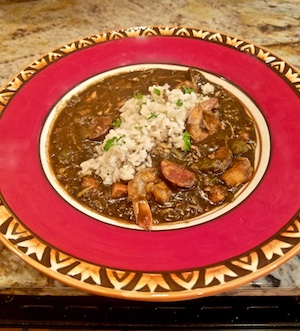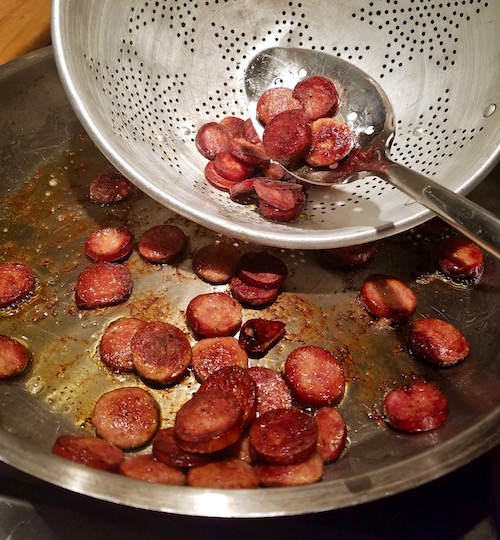My Twist On Louisiana Gumbo Will Surprise You

Here’s my twist on the classic Louisiana Gumbo dish. “Cultural Appropriation” this is not. Why? Because I’m naming boundaries and giving them their due. Also, because cooks are always exploring, always re-imagining dishes, and that’s how cuisine evolves. This recipe is long on technique, so you really have to enjoy cooking. I can’t decide on a name for this dish. Is it gumbo? Maybe its “Gumbo-Inspired Pasilla Okra With Shrimp?” Any suggestions?
I twist the classic gumbo recipe in two ways.
First, I use Pasilla chiles, and employ the Mexican technique of re-hydrating and puréeing the dried Pasilla chile. The Pasilla chile has a deep, dark and robust flavor that matches well with the flavor of the traditional dark roux (blackened flour and fat) of the Louisiana gumbo classic.

Second, I replace the French roux technique with the Mexican roasted flour technique. The French use roux (flour cooked in fat) to thicken a sauce, and also to give color and flavor to the dish. The longer you cook the flour in the fat, the darker and more flavorful it gets, but it also starts losing its ability to thicken. In gumbo, the roux is very dark and its function is less for thickening and more for taste and color.
In Mexican cooking, we roast nixtamalized corn flour for color and taste. In Spanish, nixtamalized corn flour is called harina de maíz or masa harina, and it’s sold in the US by Quaker and Maseca. The roasted nixtamalized corn flour is called pinole. It has a delicious robust, deep flavor, and it’s used to make nutritious drinks, puddings and desserts. So, in this recipe I roast the wheat flour all by itself, with no fat, as in Mexican cooking. This achieves the depth of flavor of the dark roux.
By also rendering the fat from the sausage, this recipe cuts in half the fat content of traditional gumbo. The rendered fat is used to sauté the vegetables, thus eliminating the need for additional oil and also adding flavor. Rendering fat is a slow process, but I think it’s worth the effort.
Recipe For My Twist On Gumbo
Ingredients (Serves 8)
1 lb shrimp, peeled, deveined, heads and tails off
1 lb Andouile sausage, sliced into 1/4″ rounds
1/2 lb chicken, skin off, cut into 1″ chunks
2 Pasilla chiles, dried stems removed but with the seeds intact
2 cups onion, small dice
1 green bell pepper, seeds removed, small dice
1 cup celery, small dice
1/2 tsp salt
1/2 tsp freshly ground black pepper
1/2 tsp chile de arbol or chile japonés
3/4 cup all purpose wheat flour
6 cups chicken stock, unsalted
3 cups okra, sliced into rounds
2 bay leaves
1/2 cup fresh parsley, minced
1 Tbs garlic, minced
1/2 Tbs fresh thyme leaves, minced
1 tsp distilled white vinegar
Method
1. To render the fat from the sausage (you may have to do this in batches):
heat a large skillet on very low heat, 240° to 250°F and place the sausage slices in one layer. Cook for 9 minutes and then turn them over and cook another 9 minutes. When the sausage is cooked and a bit crispy, use a slotted spoon and place in a sieve or colander and press down to extract any additional oil. Remove to a plate and set aside.

2. To the rendered sausage fat, add the chicken and cook over medium heat for about 3 minutes until it browns slightly. Remove with a slotted spoon and set aside.
3. Add the onions, green bell pepper and celery, cover and cook on low heat for about 7 minutes, until the onion is translucent and the bell pepper is soft. Add 2 cups of chicken stock and deglaze the pan, scraping the bottom well to completely remove all the brown bits. Set aside.
4. Place the 2 Pasilla chiles in a small saucepan, cover them with water and bring to a boil. Turn off the heat and let the chiles, with seeds, rehydrate for 15 minutes.
5. Meanwhile, in a cast-iron or heavy bottom skillet on medium heat, cook the flour until the color turns a very dark brown. Keep stirring constantly for even cooking. It should be the color of rusted iron. Be careful not to burn it. Place the darkened flour on a plate and allow to cool.
6. Place the chiles, with seeds, in a blender, along with the salt, black pepper, chile de arbol, cooked flour and 4 cups of chicken stock. Blend on high for several minutes until the mixture is a fine, smooth purée with no large particles.
7. In a dutch oven, add the purée, the cooked vegetables, chicken, sausage and stir together. Add the okra, bay leaf, thyme, parsley, garlic and vinegar. Cover and simmer for 45 minutes.
8. Uncover, add the shrimp and cook an additional 15 minutes.
Serve in bowls with a small dollop of rice and garnish with parsley.
Bon Appétit !
Adán,
First of all, I found this recipe and your site by googling “gumbo with a twist.” I am forever trying to make a deep dark, earthy gumbo that honors its roots (I love tomatoes, but they have no place in gumbo). Making the roasted flour was new to me and a little nerve-wracking- it would have been nice to see a photo of the end result to know how far to go- but I think I did well. The pasilla peppers added heat and depth. In short, I thought this was an interesting take on gumbo that does not betray the soul of the dish. I plan to share it with my family from Lafayette. Thank you!
Thanks for the heads up on the recipe, Jessica. You’ll find pasilla chiles abundant in most Austin grocery stores. Let me know how it turns out.
These tweaks look really good! I would love to try them if I can find some dried pasilla peppers here in Austin. I did notice that the chicken never makes it back into the gumbo in this recipe!